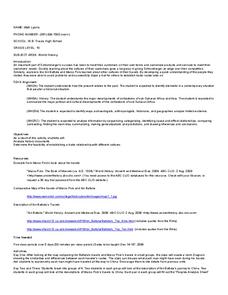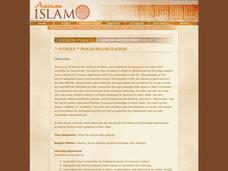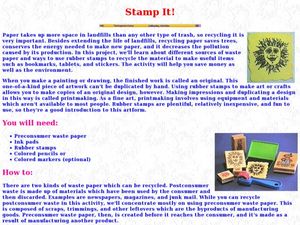Curated OER
Medieval Travelers
Tenth graders explore the impact of trade on culture. In this trade lesson, 10th graders compare the travels of Marco Polo and Ibn Battuta. Students research the explorers and create materials for a gallery walk that feature the impact...
Curated OER
Piece Like a River
Students investigate water formations by creating a puzzle. In this water properties instructional activity, students create a giant river puzzle by drawing on large butcher paper as a class, then dividing the image up into many...
Curated OER
All Quiet On The Western Front
Students create a poem on the subject of war. In this All Quiet on the Western Front lesson, students create poetry using phrases or lines that they brainstorm during a pre-writing session. Students enhance their poetry with sensory...
Curated OER
"Hard" Data from Space
Students use satellite images to analyze development patterns within Baltimore City. They prepare a land cover map for Baltimore indicating the prevalence of impervious surfaces and explore how these patterns affect water pollution.
Curated OER
Critical Viewer Activity
Students practice media awareness. In this media awareness lesson, students analyze print and electronic media messages. Students discover how advertisers use re-imaging to manipulate photographs and discuss how they can become critical...
Curated OER
Innovations in Media
Students analyze Pablo Picasso's art. In this Picasso art analysis lesson, students define collage and analyze Picasso's work in different mediums. Students complete image based discussion activities. Students use found objects to create...
Curated OER
Living on the Edge - "Illegal Art"
Students explore how copyright and trademark laws impact art. After researching cases on the topic, students use and existing postcard as the basis for a new piece of art.
Curated OER
Environment: Just Around the Bend
Students decipher landforms on a map and corresponding satellite imagery. They consider the impact of pollution on agriculture and water. They draw diagrams demonstrating how pollution works its way into the food source.
Curated OER
Classification of Clouds
Students view progressive slides of cloud formations and identify which type of cloud is shown as it forms. They estimate the cloud's height while viewing each image.
Curated OER
I Want To Take A Picture In 1866!
Eighth graders examine the role of technology. In the Civil War lesson, 8th graders look at the advent of photography and determine the impact of photography on the Civil War.
Curated OER
Women's Votes, Women's Voices
Learners investigate Women's Suffrage by analyzing images from the past. In this equal rights activity, students read biographical work about Emma Smith DeVoe, an activist who fought for women's rights. Learners view a comic style...
Curated OER
Fugitive Slave Act of 1850
Students take a closer look at the Fugitive Slave Act of 1850. In this slavery lesson, students examine an image and read excerpts from Uncle Tom's Cabin as well as the Fugitive Slave Act of 1850. Students discuss their analysis of the...
Curated OER
Putting It All Together: Creating an artifact
Eleventh graders analyze a variety of images and documents, then create artifacts to archive, such as a newspaper, an album, or scrapbook from their writings, drawings, and projects. They present learned information to their peers
Curated OER
American Pop Icons
Pupils analyze art and decide if the images are an attempt to celebrate or criticize American Popular Culture of the fifties and sixties and discuss how successful "Pop Art" mirrored society. Students also discuss the difference between...
Curated OER
Become An Expert!
Students become aware of the history to the Missouri quarter. Students combine two historically significant images: the famous explorers Lewis and Clark and the Gateway Arch. Students explore the rich history of this state.
Curated OER
Qur'an: Sacred Scripture of Islam
Students discover the strong emphasis Islam puts on education. Using the Internet, they identify advancements in ethics, math and astronomy. They explain the importance of madrasahs, or traditional places of learning in Islam, and...
Curated OER
Soil Morphology
Students analyze images of five different soil types from various locations and discuss how climate, vegetation, parent material, topography, and time can contribute to soil characteristics.
Curated OER
For Goodness Sake, Power to the People
Students examine the impact of the nonprofit sector on society by researching philanthropic Websites. They role-play as minority groups that used alternative power structures to change society and write in their journals on a...
Curated OER
Henry Luce: Turn Me Luce
Students research the life of Henry Luce, Time Magazine's founder, and examine the impact his magazine has had on the way American's see the world. They create a photo-essay, magazine or video to present their research.
Curated OER
No Publicity, Bad Publicity?
Students examine the factors that can influence a celebrity's media image and marketplace viability. They read an article, answer discussion questions, role-play advisors to a studio head, and write a letter to a studio head.
Curated OER
Women and the Negro Baseball Leagues
This lesson is designed to raise awareness of women's importance and contributions to society and to the preservation of history. Women played, coached watched, and supported the game of baseball. Students research players, coaches, and...
Curated OER
The Ancient Cliff Dwellers of Mesa Verde
Students research evidence discovered during Mesa Verde archaeological dig, view images of ancient artifacts, simultate real dig and reconstruct items buried on school grounds, and create newsletter or video tape skit.
Curated OER
Stamp It
High schoolers pick a theme related to the Mississippi River Valley and conduct research using a variety of resources while constructing a commemorative stamp of the topic. The stamp is made using a visual image found in the information.
Curated OER
Who Will Care for the Water?
Students discover how humans impact natural resources. In this environmental lesson, students identify water resources in the local area and construct a T-chart to compare the positive and negative effects humans have on water resources.

























